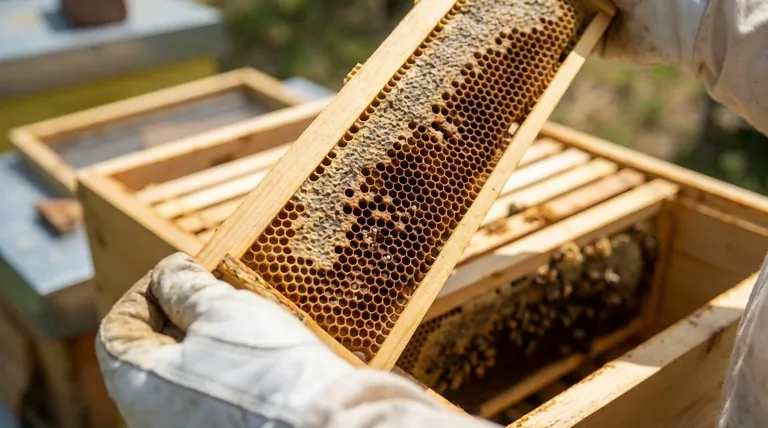Confirming a nuc is 'queenright' is the essential process of verifying it contains a healthy, mated, and actively laying queen. This check is typically performed about three weeks after introducing a queen cell, which allows enough time for the new queen to emerge, complete her mating flights, and begin laying eggs.
A queenright colony is fundamentally defined by the presence of eggs and developing larvae, not just by a visual sighting of the queen herself. This evidence confirms the queen is fertile and the colony has a viable future.

The Core Signs of a Queenright Nuc
To determine if your nucleus colony is queenright, you must perform a careful frame-by-frame inspection. You are looking for definitive evidence that a productive queen is present and accepted by the colony.
The Primary Indicator: The Presence of Eggs
The most crucial sign of a laying queen is the presence of freshly laid eggs. These can be difficult for the untrained eye to spot.
Tilt a frame of drawn comb so the sunlight illuminates the bottom of the cells. You are looking for a single, tiny, white egg standing upright in the center of each cell. A healthy queen lays in a methodical pattern, so you should see many of these in a concentrated area.
Evaluating the Brood Pattern
As eggs hatch into larvae, you can evaluate the queen's laying quality by observing the brood pattern.
A strong queen will lay eggs in a tight, concentric pattern, creating a solid area of brood of similar age. This results in a dense patch of capped brood that looks like a solid, slightly raised surface on the comb. A spotty or scattered pattern can indicate a failing or poorly mated queen.
Observing Bee Behavior
The colony's overall temperament can also be an indicator. A queenright colony is typically calm and focused on its tasks.
In contrast, a queenless colony often becomes agitated, louder (a distinct "queenless roar"), and may exhibit aimless, disorganized behavior on the combs.
Understanding Complications and False Signals
Sometimes the signs are not straightforward. Understanding what to look for when things are not ideal is critical for making the right decision.
The Meaning of Queen Cells
Finding queen cells in an established nuc can be alarming. You must interpret their meaning based on their location and the colony's condition.
Supersedure cells are queen cells typically found on the face of the comb. These indicate the bees are trying to replace a queen they perceive as failing (e.g., poor pheromone output or spotty laying).
Swarm cells are usually found along the bottom edges of the frames. Their presence in a crowded nuc means the colony is preparing to swarm due to a lack of space.
The Queenless Scenario
If, after three to four weeks, you find no eggs, no larvae, and no sign of a queen, the nuc is likely queenless. This can happen if the virgin queen failed to return from her mating flight or was otherwise lost. A queenless colony is doomed without intervention.
The standard solution is to introduce a new, caged, and already-mated queen. This allows the colony to acclimate to her pheromones before releasing her, increasing the odds of acceptance and bringing the nuc back on track quickly.
Making the Right Choice for Your Goal
Your findings during the inspection will dictate your next steps. The colony's survival and productivity depend on a swift and accurate response.
- If your primary focus is confirmation: The presence of eggs, one per cell in a concentrated area, is the definitive proof that your nuc is queenright.
- If your primary focus is problem-solving: The absence of eggs after the expected timeline means you must introduce a mated queen to save the colony.
- If your primary focus is colony management: The presence of queen cells requires you to diagnose whether the colony is attempting to supersede a failing queen or preparing to swarm.
Ultimately, careful and regular observation is the cornerstone of successful beekeeping.
Summary Table:
| Sign of a Queenright Nuc | What to Look For |
|---|---|
| Presence of Eggs | Single, white eggs standing upright in the center of cells. |
| Healthy Brood Pattern | A tight, solid patch of capped brood of similar age. |
| Calm Bee Behavior | Bees are focused and organized, not agitated or loud. |
| Warning Signs (Queenless) | No eggs/larvae, 'queenless roar,' or numerous emergency queen cells. |
Ensure your apiary's success with reliable equipment from HONESTBEE. A queenright colony is the foundation of a thriving beekeeping operation. Whether you're a commercial apiary managing hundreds of hives or a distributor supplying the industry, having the right tools for inspections and queen management is crucial. From durable nuc boxes to essential hive tools, HONENTBEE supplies the high-quality, wholesale-focused beekeeping equipment you need to support healthy, productive colonies. Let's discuss your specific needs — contact our expert team today to streamline your operations and boost your productivity.
Visual Guide

Related Products
- Nicot Queen Rearing Kit for Beekeeping and Grafting in Nicot System
- Jenter Queen Rearing Kit Complete Set for Bee Breeding
- No Grafting Queen Rearing Kit: System for Royal Jelly Production and Queen Rearing
- Durable Galvanized Steel Spring Queen Bee Cage
- Vertical Motor Kits for 2 3 4 Frame Electric Honey Extractors
People Also Ask
- What is essential for successful queen rearing in beekeeping? Master Genetics & Boost Your Apiary's Health
- What is the Doolittle method of queen rearing? Master Controlled Queen Production for Your Apiary
- How can beekeepers start a honey bee breeding program? Build a Superior, Resilient Apiary
- What should be done once eggs are present in the comb box? A Guide to Maximizing Queen Rearing Success
- What are the benefits of queen rearing for beekeepers? Gain Total Control Over Your Apiary's Genetics



















